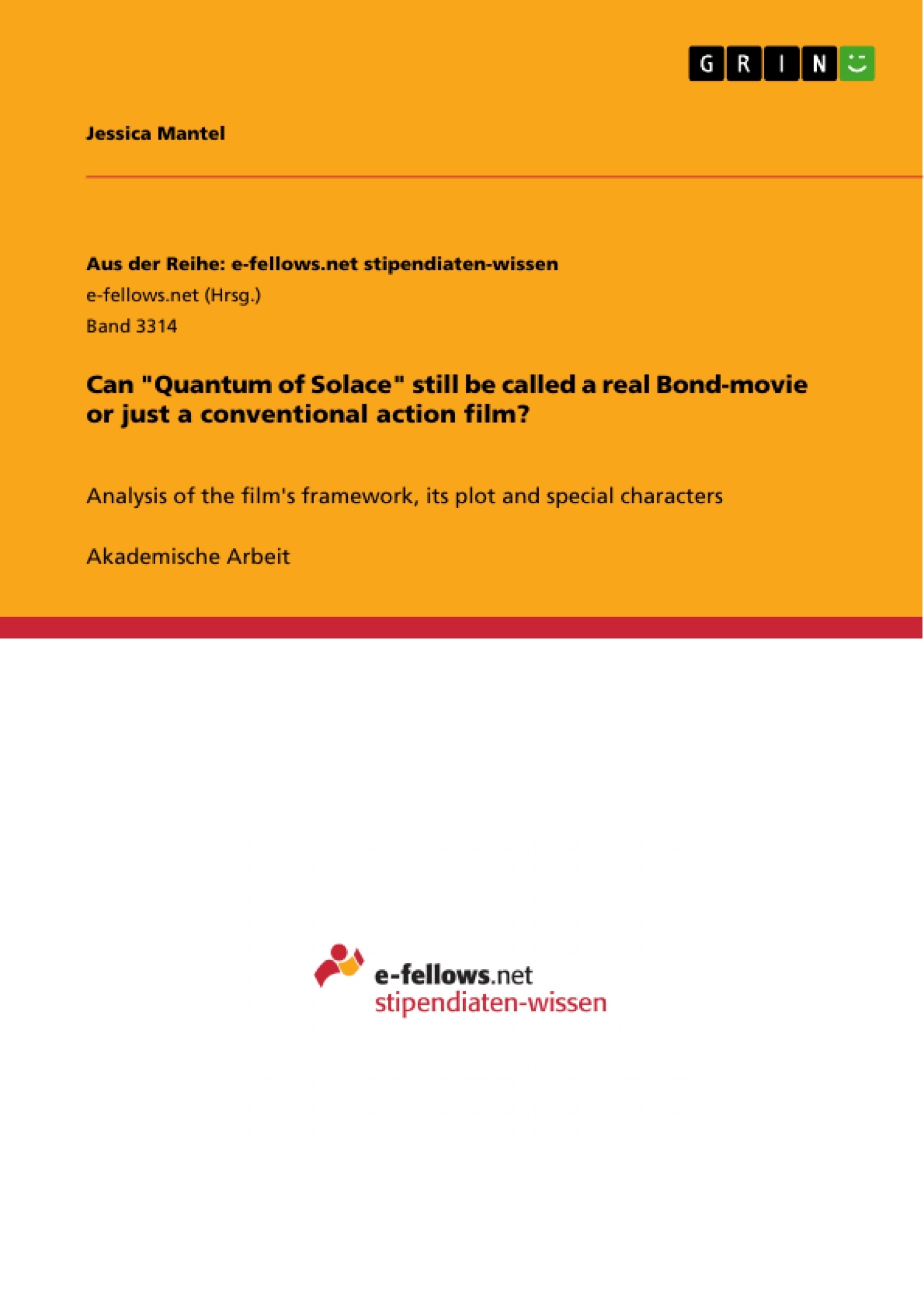In the following, this term paper will analyze that question whether "Quantum of Solace" can still be called a real Bond-movie or just a conventional action filmby taking into account the film`s framework as well as its plot and special characters.
James Bond is not just any action hero. He is the one that already fought against the most threatening villains in 24 movies over the last 55 years. Over this half century only six actors had the honour to play this popular character and of course every single one of them had a different understanding of its personality and thus varied its defining character traits. Although some of the films have been liked better by the viewers than others, they all were highly successful regarding the box-office and thousands of reviews.
Inhaltsverzeichnis
- 1. INTRODUCTION
- 1.1 THE JAMES BOND FRANCHISE AND ITS EXCEPTIONS
- 1.2 ANNOTATIONS
- 2. EXAMINATION
- 2.1 MORE THAN JUST A STORY - THE FRAMEWORK
- 2.1.1 The first impression - title, title song and title sequence
- 2.1.2 Unerring: the gun barrel sequence
- 2.2 PRINCIPAL ELEMENT - THE PLOT
- 2.2.1 Serial character
- 2.2.2 The storyline's structure
- 2.2.3 Characterising expressions
- 2.2.4 References to other 007 movies
- 2.2.5 The final clash
- 2.3 GOOD, BAD, BOND – THE DIFFERENT CHARACTERS
- 2.3.1 007 licence to kill
- 2.3.2 Target: the evil rival
- 2.3.3 His darling Moneypenny
- 2.3.4 Attractive, armed, amazing – the Bond girl(s)
- 3. CONCLUSION
- 3.1 TO SUM IT UP
- 3.2 PERSONAL OPINION
Zielsetzung und Themenschwerpunkte
Diese Arbeit untersucht die Abweichungen von der etablierten James-Bond-Formel im 22. Film der Reihe, "Quantum of Solace" (2008). Ziel ist es, zu analysieren, inwieweit der Film noch als typischer Bond-Film betrachtet werden kann oder ob er sich von der Tradition abgrenzt. Die Analyse konzentriert sich auf den filmischen Rahmen, die Handlung und die Charaktere.
- Analyse der James-Bond-Formel und ihrer Bestandteile
- Vergleich der traditionellen Elemente mit "Quantum of Solace"
- Bewertung der Abweichungen und ihrer Auswirkungen auf den Film
- Diskussion der Kritik an "Quantum of Solace"
- Untersuchung der Frage nach der Identität des Films als Bond-Film
Zusammenfassung der Kapitel
1. Introduction: Dieses einleitende Kapitel stellt den James-Bond-Franchise und seine aussergewöhnliche Erfolgsgeschichte vor. Es hebt die Konstanz bestimmter Elemente in den Filmen hervor und benennt "Quantum of Solace" (2008) als Ausnahme, die kontroverse Meinungen hervorgerufen hat. Der Fokus liegt auf der Frage, ob "Quantum of Solace" noch als echter Bond-Film gilt, was im weiteren Verlauf der Arbeit untersucht werden soll. Die Einleitung skizziert den methodischen Ansatz der Analyse, der sich auf den filmischen Rahmen, die Handlung und die Charaktere konzentrieren wird. Die Herausforderungen bei der Recherche, insbesondere bezüglich der Verfügbarkeit von Quellen, werden ebenfalls angesprochen.
2. Examination: Dieses Kapitel analysiert die weltweite Popularität der James-Bond-Filme und die Entwicklung bestimmter wiederkehrender Elemente. Es betont den Einfluss von Schlüsselfiguren aus dem ersten Film, wie Ken Adams (Produktionsdesigner) und John Barry (Komponist), auf die visuelle Gestaltung und musikalische Begleitung der gesamten Reihe. Der Kapitel betont auch die Existenz einer "Bond-Formel", die die langjährige Erfolgsgeschichte erklärt, und kündigt die detaillierte Untersuchung der Abweichungen in "Quantum of Solace" an, um die Frage nach dessen Identität als Bond-Film zu beantworten.
Schlüsselwörter
James Bond, Quantum of Solace, Bond-Formel, Filmanalyse, Handlung, Charaktere, filmischer Rahmen, Abweichungen von der Tradition, Kontroverse, Actionfilm, Erfolgsgeschichte, James-Bond-Franchise.
Häufig gestellte Fragen (FAQ) zu "Analyse von Quantum of Solace"
Was ist der Gegenstand der Analyse?
Die Analyse untersucht den 22. James-Bond-Film, "Quantum of Solace" (2008), und seine Abweichungen von der etablierten James-Bond-Formel. Es wird analysiert, inwieweit der Film noch als typischer Bond-Film betrachtet werden kann oder ob er sich von der Tradition abgrenzt.
Welche Aspekte des Films werden untersucht?
Die Analyse konzentriert sich auf drei Hauptaspekte: den filmischen Rahmen (Titel, Titellied, Titelsequenz, Gun Barrel Sequence), die Handlung (Struktur, Charakterisierung, Referenzen zu anderen Filmen) und die Charaktere (Bond, Bösewicht, Moneypenny, Bond-Girl).
Welche Ziele verfolgt die Analyse?
Ziel der Analyse ist es, die James-Bond-Formel zu definieren und zu analysieren, wie "Quantum of Solace" diese Formel befolgt oder bricht. Es soll bewertet werden, welche Auswirkungen diese Abweichungen auf den Film haben und die Kritik an dem Film diskutiert werden. Letztlich soll die Frage beantwortet werden, ob "Quantum of Solace" noch als ein typischer Bond-Film gilt.
Wie ist die Arbeit strukturiert?
Die Arbeit ist in drei Kapitel gegliedert: Eine Einleitung, die den Kontext und die Methodik beschreibt; ein Hauptteil, der die Analyse des filmischen Rahmens, der Handlung und der Charaktere vornimmt; und ein Schluss, der die Ergebnisse zusammenfasst und eine persönliche Meinung abgibt. Die Arbeit beinhaltet auch ein detailliertes Inhaltsverzeichnis, eine Zusammenfassung der Kapitel und Schlüsselwörter.
Welche Themenschwerpunkte werden behandelt?
Die Analyse behandelt Themen wie die James-Bond-Formel und ihre Bestandteile, den Vergleich traditioneller Elemente mit "Quantum of Solace", die Bewertung von Abweichungen und deren Auswirkungen, die Diskussion der Kritik an dem Film und die Frage nach der Identität des Films als Bond-Film.
Welche Quellen wurden verwendet?
Die bereitgestellte HTML-Datei gibt Hinweise auf die Herausforderungen bei der Recherche und die Verfügbarkeit von Quellen. Konkrete Quellenangaben sind in der Datei selbst nicht enthalten.
Welche Schlüsselwörter beschreiben die Arbeit?
Schlüsselwörter sind: James Bond, Quantum of Solace, Bond-Formel, Filmanalyse, Handlung, Charaktere, filmischer Rahmen, Abweichungen von der Tradition, Kontroverse, Actionfilm, Erfolgsgeschichte, James-Bond-Franchise.
- Quote paper
- Jessica Mantel (Author), 2017, Can "Quantum of Solace" still be called a real Bond-movie or just a conventional action film?, Munich, GRIN Verlag, https://www.grin.com/document/508682



